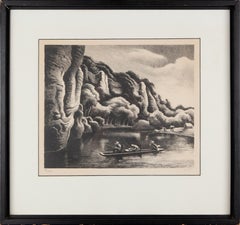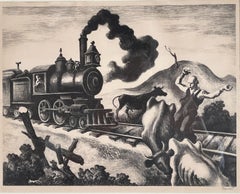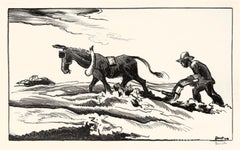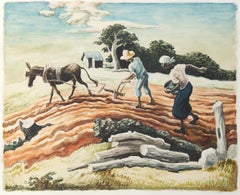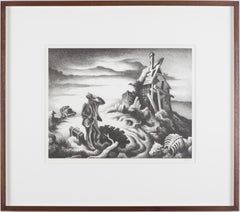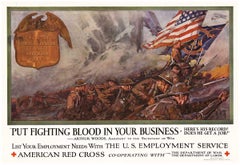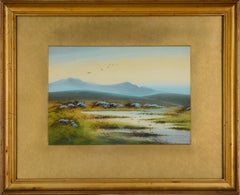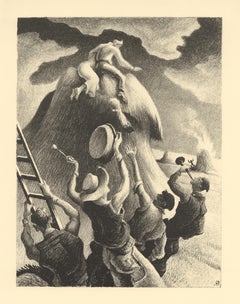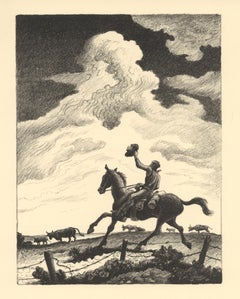Thomas Hart Benton Art
American, 1889-1975
Thomas Hart Benton was born in Neosho, Missouri on April 15, 1889. Even as a boy, he was no stranger to the "art of the deal" or to the smoke-filled rooms in which such deals were often consummated. His grandfather had been Missouri's first United States Senator and served in Washington for thirty years. His father, Maecenas Benton, was United States Attorney for the Western District of Missouri under Cleveland and served in the United States House of Representatives during the McKinley and Theodore Roosevelt administrations. Benton's brother, Nat, was prosecutor for Greene County, Missouri, during the 1930s.
As soon as he could walk, Benton traveled with his father on political tours. There he learned the arts of chewing and smoking, and while the men were involved in their heated discussions, Benton delighted in finding new cream colored wallpaper on the staircase wall, at the age of six or seven, and drew in charcoal his first mural, a long multi-car freight train.
As soon as he was eighteen, even though his father wanted him to study law, Benton left for Chicago where he studied at the Art Institute during the years 1907 and 1908. He continued his studies in Paris, where he learned delicious wickedness, aesthetic and otherwise.
Once back home, he became the leader of the Regionalist School, the most theatrical and gifted of the 1930s muralists and as Harry Truman described him,"the best damned painter in America."
Detractors said that Benton was "a fascist, a communist, a racist and a bigot"; the ingenious structure, powerful use of modeling and scale and the high-colored humanity of the murals and easel paintings are retort enough. He was a dark, active dynamo, only 5 ft., 3 1/2 in. tall. He was outspoken, open, charmingly profane; he had a great mane of hair and a face the texture of oak bark. He wore rumpled corduroy and flannel, and walked with the unsteady swagger of a sailor just ashore. He poured a salwart drink, chewed on small black cigars and spat in the fire.
Benton was once described as the "churlish dean of regionalist art." If you listened to a variety of art authorities, you would find them equally divided between Harry Truman's assessment of Benton as "the best damned painter in America" and Hilton Kramer who proclaimed Benton "a failed artist."
The East Coast art establishment tended to regard Benton as memorable for one reason only: he was the teacher of Jackson Pollock.
Benton was married in 1922 to Rita, a gregarious Italian lady, and they had a daughter and a son. At the height of his fame in the 1940s, Benton bungled the buy-out he was offered by Walt Disney and went his own way, completing his last mural in 1975 in acrylics the year of his death.
He died in 1975.to
1
14
6
20
17
7
6
2
2
2
Making Camp
By Thomas Hart Benton
Located in Columbia, MO
Thomas Hart Benton (American, 1889 - 1975) was a painter, muralist, and printmaker whose sinuous, rhythmic style came to define the Regionalist movement. His paintings and lithograph...
Category
20th Century American Modern Thomas Hart Benton Art
Materials
Lithograph
Mural Study for "History of Water" American Scene Modernism Social Realism WPA
By Thomas Hart Benton
Located in New York, NY
Mural Study for "History of Water" American Scene Modernism Social Realism WPA
Thomas Hart Benton (American, 1889-1975)
"Water Story" (Study for The History of Water)
Tempera and o...
Category
1930s American Modern Thomas Hart Benton Art
Materials
Oil, Egg Tempera, Board
SLOW TRAIN THROUGH ARKANSAS
By Thomas Hart Benton
Located in Portland, ME
Benton, Thomas Hart (American, 1889-1975 SLOW TRAIN THROUGH ARKANSAS. Fath . Lithograph, 1941. Edition of 250 published by Associated American Artists (A.A.A.). 9 7/8 x 12 inches (im...
Category
1940s Thomas Hart Benton Art
Materials
Lithograph
'Plowing It Under' — WPA Era American Regionalism
By Thomas Hart Benton
Located in Myrtle Beach, SC
Thomas Hart Benton, 'Goin' Home', lithograph, 1937, edition 250, Fath 14. Signed in pencil. Signed in the stone, lower right. A fine, richly-inked impression, on off-white, wove pape...
Category
1930s American Realist Thomas Hart Benton Art
Materials
Lithograph
Planting (Spring Plowing) - Watercolor Landscape Painting with Figures, c. 1939
By Thomas Hart Benton
Located in Palm Desert, CA
"Planting (Spring Plowing)", a vibrant watercolor and graphite on paper by Thomas Hart Benton, circa 1939-40, embodies the artist's signature Regionalist style. The work depicts a ru...
Category
Mid-20th Century American Impressionist Thomas Hart Benton Art
Materials
Paper, Watercolor, Graphite
Prodigal Son
By Thomas Hart Benton
Located in London, GB
A man raises his hand to his chin, his neck tilted and face turned to look at a dilapidated farmhouse, barely held together by planks of wood and exposed to the elements. Behind him ...
Category
1930s American Modern Thomas Hart Benton Art
Materials
Lithograph
INSTRUCTION
By Thomas Hart Benton
Located in Santa Monica, CA
THOMAS HART BENTON (1889-1975)
INSTRUCTION 1940 (Fath 41)
Lithograph, signed edition of 250 as published by Associated American Artists.
10 ¼” x 12 ¼”. Full margins, deckle edges....
Category
1940s American Realist Thomas Hart Benton Art
Materials
Lithograph
Down the River
By Thomas Hart Benton
Located in London, GB
In this sentimental work from 1939, Benton expresses his admiration for the rural lifestyle of the Midwest. He highlights the connection between man and the land by depicting two fig...
Category
1930s American Modern Thomas Hart Benton Art
Materials
Lithograph
Thomas Hart Benton Original Lithograph, 1944 - Wreck of the Ol’ ‘97
By Thomas Hart Benton
Located in Phoenix, AZ
Original stone lithograph created 1944 by well-known Regionalist Thomas Hart Benton.
The print is in excellent condition with full margins and pencil signed lower right. Also signed in the stone.
It is matted in a 4-ply archival mat and rests in a simple black frame.
Image size: 10 ½ x 15. Frame size: 18 x 23. Published by AAA. Ed: 250.
Thomas Hart Benton found inspiration for his art in the ebb and flow of daily life in rural and small-town America. Wreck of the Ol’ 97, one of his best-known prints, is based on a ballad of the same title that tells the story of a rail disaster. A speeding locomotive attempting to make up lost time jumped the tracks as it descended a Virginia mountain...
Category
Mid-20th Century Thomas Hart Benton Art
Materials
Paper, Lithograph
Forward Pass
By Thomas Hart Benton
Located in New York, NY
Lithograph on wove paper, 1972. Signed by the artist in pencil, lower right. Inscribed "Ed. 250" in pencil, lower left. Published by Associated American Artists, New York.
Catalog...
Category
1970s American Realist Thomas Hart Benton Art
Materials
Lithograph
Nebraska Evening
By Thomas Hart Benton
Located in London, GB
A fine impression with good margins published by Associated American Artists.
Category
1940s American Modern Thomas Hart Benton Art
Materials
Lithograph
Haystack
By Thomas Hart Benton
Located in London, GB
A fine impression of this very popular image with full margins (smaller on top and bottom) published by Associated American Artists.
Category
1930s American Modern Thomas Hart Benton Art
Materials
Lithograph
Thomas Hart Benton Original Lithograph, 1939 - "Shallow Creek"
By Thomas Hart Benton
Located in Phoenix, AZ
Original stone lithograph by well-known Regionalist Thomas Hart Benton (1889-1975).
Titled: "Shallow Creek.” The print has full margins and is in excellent condition.
AAA print creat...
Category
1930s Thomas Hart Benton Art
Materials
Paper
Discussion
By Thomas Hart Benton
Located in London, GB
In this charming regionalist lithograph, Benton captures a classic Midwestern American scene: two men talking, drinking, and smoking together in a bar. Titled 'Discussion', the artwo...
Category
1930s American Modern Thomas Hart Benton Art
Materials
Lithograph
"FANTASY" Oil on Canvas by Thomas Hart Benton
By Thomas Hart Benton
Located in New York, NY
"FANTASY" by Thomas Hart Benton. Oil on canvas laid on wood with a gorgeous gold gilded frame. Price upon request.
Category
1940s American Mid-Century Modern Vintage Thomas Hart Benton Art
Materials
Canvas, Paint
Old Man Reading
By Thomas Hart Benton
Located in London, GB
Accompanied by a lantern, an elderly man sits alone, engrossed in a newspaper. Benton used a lithographic process to draw and produce this image. He renders the face and paper well-l...
Category
1940s American Modern Thomas Hart Benton Art
Materials
Lithograph
"White Calf, " Farm Genre Scene Original Lithograph by Thomas Hart Benton
By Thomas Hart Benton
Located in Milwaukee, WI
"White Calf" is an original lithograph print by Thomas Hart benton. It features the image of a man milking a cow while her calf lays down in front. Benton's breathtaking way of rende...
Category
1940s American Modern Thomas Hart Benton Art
Materials
Lithograph
Self Portrait (~24% OFF LIST PRICE, Midwestern Art, American Painter, Modern)
By Thomas Hart Benton
Located in Kansas City, MO
Thomas Hart Benton
Self Portrait
1972
Lithograph
Image Size: 19.5 x 13.75 inches
Matted Size: 28.5 x 22.25 inches
Edition: 300
Signed by hand, lower right
COA provided
Ref.: Fath, 84...
Category
1970s Modern Thomas Hart Benton Art
Materials
Lithograph
HYMN SINGER / THE MINSTREL / BURL IVES -- Large Benton
By Thomas Hart Benton
Located in Santa Monica, CA
THOMAS HART BENTON (1890- 1975)
HYMN SINGER / THE MINSTREL (Portrait of Burl Ives) 1950 (Fath 74)
Lithograph signed with full signature “Thomas H. Benton” A large image, 15 ¾ x 12 i...
Category
1950s American Realist Thomas Hart Benton Art
Materials
Lithograph
The Hymn Singer
By Thomas Hart Benton
Located in Missouri, MO
Signed in Pencil Lower Right
Ed. 500
Circulated by Twayne Publishers, New York City
Image Size: 16 x 12 3/8
Framed Size: 24 1/4 x 20 1/2 inches
The legendary actor actor and musici...
Category
1950s American Realist Thomas Hart Benton Art
Materials
Lithograph
Price Upon Request
Related Items
Put Fighting Blood in Your Business
Located in Spokane, WA
Original WW1 poster. Put Fighting Blood in Your Business. Here’s his record! Does he get a Job? Arthur Woods, Assistant to the Secretary of...
Category
1910s American Realist Thomas Hart Benton Art
Materials
Lithograph
1920's Peaceful Marsh Wetlands Watercolor Landscape with Birds
Located in Soquel, CA
Serene 1920's watercolor landscape of calm water snaking through a lush marshy wetland, dotted with small birds, wildflowers and swaying grass, by an unknown artist (American, 20th C...
Category
1920s American Impressionist Thomas Hart Benton Art
Materials
Paper, Watercolor
$348 Sale Price
20% Off
H 13 in W 16 in D 1 in
Mary Lightfoot, Street Scene in Taos
Located in New York, NY
Mary Lightfoot was born in Ravenna, Texas. She studied at the College of Industrial Arts in Denton and the North Texas State Teachers College prior to receiving a master of arts degree from Columbia University. Her entire teaching career was with the Dallas Public School system; she summered in Europe...
Category
Mid-20th Century American Modern Thomas Hart Benton Art
Materials
Lithograph
"Arquebusiers En Manoeuvre", After Marchetti
Located in Soquel, CA
Figurative landscape of four infantrymen in formation with their long arquebus guns by Adolphe Ancker (Dutch, 19th Century), after Marchetti. Signed and dated "Adolph Ancker 1888" lo...
Category
1880s American Impressionist Thomas Hart Benton Art
Materials
Paper, Watercolor, Pencil
A Dynamic 1930s Boxing Match Painting by Famed Chicago Artist, Francis Chapin
By Francis Chapin
Located in Chicago, IL
A dynamic, colorful 1930s painting of a boxing match in Mexico by famed Chicago Modern artist Francis Chapin. Painted during one of the artist's early trips to Mexico, an exceptional painting showing Chapin's steadfast interest in sporting scenes, particularly boxing matches. Image size: 12 x 28 inches. Framed size: 15 1/2 x 31 1/2 inches. Estate stamped on reverse. Provenance: Estate of the artist.
Francis Chapin, affectionately called the “Dean of Chicago Painters” by his colleagues, was one of the city’s most popular and celebrated painters in his day. Born at the dawn of the 20th Century in Bristolville, Ohio, Chapin graduated from Washington and Jefferson College near Pittsburgh, Pennsylvania before enrolling at the Art Institute of Chicago in 1922. He would set down deep roots at the Art Institute of Chicago, exhibiting there over 31 times between 1926 and 1951. In 1927 Chapin won the prestigious Bryan Lathrop Fellowship from the Art Institute – a prize that funded the artist’s yearlong study trip to Europe. Upon his return to the United States, Chapin decided to remain in Chicago, noting the freedom Chicago artists have in developing independently of the pressure to conform to pre-existing molds (as was experienced by artists in New York, for example). Chapin became a popular instructor at the Art Institute, teaching there from 1929 to 1947 and at the Art Institute’s summer art school in Saugatuck, Michigan (now called Oxbow) between 1934 – 1938 (he was the director of the school from 1941-1945). Chapin’s contemporaries among Chicago’s artists included such luminaries as Ivan Le Lorraine Albright...
Category
1930s American Modern Thomas Hart Benton Art
Materials
Canvas, Oil
$1,800
H 15.5 in W 31.5 in D 1.25 in
Original California Ferrari Louis Vuitton Parc de Bagatelle hand signed poster
By Razzia (Gérard Courbouleix–Dénériaz)
Located in Spokane, WA
Original 1989 Louis Vuitton Automobile Classiques Poster –Hand Signed, Archival Linen-Backed. This poster was created for the Concours d’Elegance ...
Category
1980s American Modern Thomas Hart Benton Art
Materials
Lithograph
Original The French Riviera (Cote d'Azur) French Railways vintage travel poster
By Jules Cavailles
Located in Spokane, WA
Original vintage travel advertising poster for the FRENCH RIVIERA FRENCH NATIONAL RAILROADS SNCF (French National Railways) - the French Riviera. (Cote D'Azur, known as the French Riviera) The image features people looking out towards a marina full of sailing boats. Colorful artwork by the French painter Jules Cavailles (1901-1977). Printed by Perceval, Paris in 1953. Mid-Century Modern. Grade A-
This is the English version of the poster compared to the design created for Cote d'Azur. The English version is much rarer (both are rare today). The poster gives the impression of a naive painting at this Mediterranean beach and seaport.
Step into a world of timeless elegance and sunlit dreams with this exquisite French Riviera Vintage...
Category
1950s American Modern Thomas Hart Benton Art
Materials
Lithograph
Jules CavaillesOriginal The French Riviera (Cote d'Azur) French Railways vintage travel poster, 1953
$1,498
H 39 in W 24.5 in D 0.3 in
"The Slope Near the Bridge" Paul Sample, Mid-Century, American Snowy Landscape
By Paul Sample
Located in New York, NY
Paul Sample
The Slope Near the Bridge, 1950
Signed in pencil lower left
Lithograph on wove paper
Image 8 15/16 x 12 15/16 inches
Sheet 11 5/16 x 15 1/16 inches
From the edition of 25...
Category
1950s American Realist Thomas Hart Benton Art
Materials
Paper, Lithograph
$900
H 16.25 in W 20.25 in
'Financial District', New York City — American Modernism
By Howard Norton Cook
Located in Myrtle Beach, SC
Howard Cook, 'Financial District', lithograph, 1931, edition 75, Duffy 155. A fine, richly-inked impression, on cream wove paper, the full sheet with wide margins (2 3/4 to 5 5/8 inches), in excellent condition. Image size 13 5/16 x 10 3/8 inches (338 x 264 mm); sheet size 23 x 16 inches (584 x 406 mm). Matted to museum standards, unframed.
Literature: 'American Master Prints from the Betty and Douglas Duffy Collection', the Trust for Museum Exhibitions, Washington, D.C., 1987.
Collections: Crystal Bridges Museum of American Art, Library of Congress, Metropolitan Museum of Art, Philadelphia Museum of Art, Smithsonian American Art Museum.
ABOUT THE ARTIST
Howard Norton Cook (1901-1980) was one of the best-known of the second generation of artists who moved to Taos. A native of Massachusetts, he studied at the Art Students League in New York City and at the Woodstock Art Colony. Beginning his association with Taos in 1926, he became a resident of the community in the 1930s. During his career, he received two Guggenheim Fellowships and was elected an Academician in the National Academy of Design. He earned a national reputation as a painter, muralist, and printmaker.
Cook’s work in the print mediums received acclaim early in his career with one-person exhibitions at the Denver Art Museum (1927) and the Museum of New Mexico (1928). He received numerous honors and awards over the years, including selection in best-of-the-year exhibitions sponsored by the American Institute of Graphics Arts, the Brooklyn Museum, the Society of American Etchers, and the Philadelphia Print Club. His first Guggenheim Fellowship took him to Taxco, Mexico in 1932 and 1933; his second in the following year enabled him to travel through the American South and Southwest.
Cook painted murals for the Public Works of Art Project in 1933 and the Treasury Departments Art Program in 1935. The latter project, completed in Pittsburgh, received a Gold Medal from the Architectural League of New York. One of his most acclaimed commissions was a mural in the San Antonio Post Office in 1937.
He and Barbara Latham settled in Talpa, south of Taos, in 1938 and remained there for over three decades. Cook volunteered in World War II as an Artist War Correspondent for the US Navy, where he was deployed in the Pacific. In 1943 he was appointed Leader of a War Art Unit...
Category
1930s American Modern Thomas Hart Benton Art
Materials
Lithograph
$12,000
H 13.32 in W 10.38 in
New Brighton Eucalyptus Landscape
By Les Anderson
Located in Soquel, CA
Beautiful watercolor of eucalyptus along New Brighton beach by Les (Leslie Luverne) Anderson (American, 1928-2009). From the estate of Les Anderson in Mon...
Category
Late 20th Century American Impressionist Thomas Hart Benton Art
Materials
Watercolor, Archival Paper
Yelding the Right of Way
Located in San Francisco, CA
This artwork titled "Yelding the Right of Way" c.1975 is a color offset lithograph by renown western artist Arnold Friberg, 1913-2010. It is hand signed...
Category
Late 20th Century American Realist Thomas Hart Benton Art
Materials
Lithograph
Landscape - Lithograph by Mario Sportelli - 1980s
By Mario Sportelli
Located in Roma, IT
Landscape is an original lithograph on cardboard, realized by Mario Sportelli in 1980s.
The state of preservation is very good.
Hand-signed on the lower right
Edition of 100 copi...
Category
1980s Modern Thomas Hart Benton Art
Materials
Lithograph
$264
H 19.49 in W 25.6 in D 0.04 in
Previously Available Items
lithograph
By Thomas Hart Benton
Located in Henderson, NV
Medium: lithograph. Executed by Thomas Hart Benton to illustrate the Lynn Riggs classic "Green Grow the Lilacs" and printed in 1954 in a limited edition of 1500 by the University of ...
Category
1950s Thomas Hart Benton Art
Materials
Lithograph
lithograph
By Thomas Hart Benton
Located in Henderson, NV
Medium: lithograph. Executed by Thomas Hart Benton to illustrate the Lynn Riggs classic "Green Grow the Lilacs" and printed in 1954 in a limited edition of 1500 by the University of ...
Category
1950s Thomas Hart Benton Art
Materials
Lithograph
lithograph
By Thomas Hart Benton
Located in Henderson, NV
Medium: lithograph. Executed by Thomas Hart Benton to illustrate the Lynn Riggs classic "Green Grow the Lilacs" and printed in 1954 in a limited edition of 1500 by the University of ...
Category
1950s Thomas Hart Benton Art
Materials
Lithograph
lithograph
By Thomas Hart Benton
Located in Henderson, NV
Medium: lithograph. Executed by Thomas Hart Benton to illustrate the Lynn Riggs classic "Green Grow the Lilacs" and printed in 1954 in a limited edition of 1500 by the University of ...
Category
1950s Thomas Hart Benton Art
Materials
Lithograph
lithograph
By Thomas Hart Benton
Located in Henderson, NV
Medium: lithograph. Executed by Thomas Hart Benton to illustrate the Lynn Riggs classic "Green Grow the Lilacs" and printed in 1954 in a limited edition of 1500 by the University of ...
Category
1950s Thomas Hart Benton Art
Materials
Lithograph
lithograph
By Thomas Hart Benton
Located in Henderson, NV
Medium: lithograph. Executed by Thomas Hart Benton to illustrate the Lynn Riggs classic "Green Grow the Lilacs" and printed in 1954 in a limited edition of 1500 by the University of ...
Category
1950s Thomas Hart Benton Art
Materials
Lithograph
'Goin' Home' — WPA Era American Regionalism
By Thomas Hart Benton
Located in Myrtle Beach, SC
Thomas Hart Benton, 'Goin' Home', lithograph, 1937, edition 250, Fath 14. Signed in pencil. Signed in the stone, lower right. A fine, richly-inked impression, on off-white, wove paper, with margins, in excellent condition. Published by Associated American Artists. Archivally matted to museum standards, unframed.
Image size 9 7/16 x 11 7/8 inches; sheet size 10 3/4 x 13 5/16 inches.
Impressions of this work are held in the following museum collections: Figge Art Museum, Georgetown University Art Collection, Indianapolis Museum of Art, Library of Congress, Metropolitan Museum of Art, and the Nelson-Atkins Museum of Art.
ABOUT THE ARTIST
“Benton’s idiom was essentially political and rhetorical, the painterly equivalent of the country stump speeches that were a Benton family tradition. The artist vividly recalled accompanying his father, Maecenas E. Benton — a four-term U.S. congressman, on campaigns through rural Missouri. Young Tom Benton grew up with an instinct for constituencies that led him to assess art on the basis of its audience appeal. His own art, after the experiments with abstraction, was high-spirited entertainment designed to catch and hold an audience with a political message neatly bracketed between humor and local color.”
—Elizabeth Broun “Thomas Hart Benton: A Politician in Art,” Smithsonian Studies in American Art, Spring 1987.
Born in 1889 in Neosho, Missouri, Thomas Hart Benton spent much of his childhood and adolescence in Washington, D.C., where his father, Maecenas Eason Benton, served as a Democratic member of Congress from 1897 to 1905. Hoping to prepare Benton for a political career, his father sent him to Western Military Academy. After nearly two years at the academy, Benton persuaded his mother to support him in attending the Art Institute of Chicago for two years, followed by two additional years at the Académie Julian in Paris.
In 1912, Benton returned to America and moved to New York to pursue his artistic career. One of his first jobs involved painting sets for silent films, which were being produced in Fort Lee, New Jersey. Benton credits this experience with equipping him with the skills necessary to create his large-scale murals.
When World War I broke out, Benton joined the Navy. Stationed in Norfolk, Virginia, he was assigned to create drawings of camouflaged ships arriving at Norfolk Naval Station. These renderings were used to identify vessels that might be lost in battle. Benton later remarked that being a "camofleur" profoundly impacted his career: "When I came out of the Navy after the First World War," he said, "I made up my mind that I wasn’t going to be just a studio painter, a pattern maker in the fashion then dominating the art world—as it still does. I began to think of returning to the painting of subjects, subjects with meanings, which people, in general, might be interested in."
While developing his Regionalist vision, Benton also taught art, first at a city-supported school and later at The Art Students League from 1926 to 1935. One of his students was a young Jackson Pollock, who regarded Benton as both a mentor and father figure. In 1930, Benton was commissioned to paint a mural for the New School for Social Research. The "America Today" mural, now permanently exhibited at the Metropolitan Museum of Art, led to many more commissions as Benton’s work gained wide recognition.
The Regionalist Movement became popular during the Great Depression of the 1930s. Painters such as Benton, Grant Wood, and John Steuart Curry rejected modernist European influences, choosing instead to depict realistic images of small-town and rural life—comforting representations of the American heartland during a period of upheaval. Time Magazine referred to Benton as "the most virile of U.S. painters of the U.S. Scene," featuring his self-portrait on the cover of a 1934 issue that included a story titled "The Birth of Regionalism."
In 1935, Benton left New York and returned to Missouri, where he taught at the Kansas City Art Institute. His outspoken criticism of modern art, art critics, and political views alienated him from many influential figures in both political and art circles. Nonetheless, Benton remained true to his beliefs, continuing to create murals, paintings, and prints that captured enduring images of American life. The dramatic and engaging characteristics of Benton’s artwork drawn the attention of Hollywood producers, leading him to create illustrations and posters for films, including his famous lithographs for the film adaptation of John Steinbeck’s "The Grapes of Wrath," produced by Twentieth Century Fox.
During the 1930s, The Limited Editions Club of New York asked Benton to illustrate special editions of three of Mark Twain’s books...
Category
1930s American Realist Thomas Hart Benton Art
Materials
Lithograph
Thomas Hart Benton Original Lithograph, 1939 - "Cradling Wheat"
By Thomas Hart Benton
Located in Phoenix, AZ
Original stone lithograph created 1939 by well-known Regionalist Thomas Hart Benton.
The print is in fine condition with full margins and pencil signed lower right.
Also signed in the stone lower left. Fath #27. Image size: 9 1/2"h x 12"w.
Title: “Cradling Wheat...
Category
20th Century Thomas Hart Benton Art
Materials
Paper
H 16.75 in W 18.5 in D 0.06 in
COMING ROUND THE MOUNTAIN
By Thomas Hart Benton
Located in Santa Monica, CA
THOMAS HART BENTON (1889-1975)
COMING ROUND THE MOUNTAIN (MISSOURI MUSICIANS) 1931 (Fath 4)
Lithograph, signed in pencil. Although Fath indicates an edition of 75, it is numbered ...
Category
1930s American Realist Thomas Hart Benton Art
Materials
Lithograph
lithograph
By Thomas Hart Benton
Located in Henderson, NV
Medium: lithograph. Executed by Thomas Hart Benton to illustrate the Lynn Riggs classic "Green Grow the Lilacs" and printed in 1954 in a limited edition of 1500 by the University of ...
Category
1950s Thomas Hart Benton Art
Materials
Lithograph
Kansas Farmyard / Missouri Farmyard
By Thomas Hart Benton
Located in Santa Monica, CA
THOMAS HART BENTON (1889-1975)
MISSOURI FARMYARD, 1936 (Fath 10) AKA KANSAS FARMYARD
Lithograph as published by Associated American Artists. Edition 250. Signed in pencil and in the...
Category
1930s American Realist Thomas Hart Benton Art
Materials
Lithograph
Thomas Hart Benton Original Lithograph, 1949, Prayer Meeting
By Thomas Hart Benton
Located in Phoenix, AZ
Original stone lithograph created 1949 by well-known Regionalist Thomas Hart Benton.
The print is in excellent condition and pencil signed lower right.
Also signed in the stone lowe...
Category
Mid-20th Century Thomas Hart Benton Art
Materials
Paper
Thomas Hart Benton art for sale on 1stDibs.
Find a wide variety of authentic Thomas Hart Benton available for sale on 1stDibs. You can also browse by medium to find art by Thomas Hart Benton in lithograph, paper, ink and more. Much of the original work by this artist or collective was created during the 20th century and is mostly associated with the modern style. Not every interior allows for large Thomas Hart Benton, so small editions measuring 7 inches across are available. Customers who are interested in this artist might also find the work of David Klein, Benton Murdoch Spruance, and Adolf Dehn. Thomas Hart Benton prices can differ depending upon medium, time period and other attributes. On 1stDibs, the price for these items starts at $100 and tops out at $8,017, while the average work can sell for $5,000.
